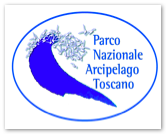National Park of the Tuscan Archipelago (Coordinator) – PNAT (ITALY)
The National Park of the Tuscan Archipelago was established by the law 394/91, by the decree D.P.R. of 22 July 1996 and by the D.M. (Ministry Act) “Environment”, 19 December 1997. The Park’s area comprises circa 18.000 hectares of land, with interesting geological and naturalistic sites, and 60.000 hectares at sea. The Tyrrhenian is populated by numerous species rare to come across today in other places, hence it is comprised in the area of the International Sanctuary for the protection of sea mammals called “Pelagos”.
The National Park’s duty is to preserve the heritage of species and eco systems of these seven islands, in a joined effort between conservation and protection and the value achieved by man. The National Park of the Tuscan Archipelago includes seven islands, unique for climate, flora, fauna, history and legend: Elba, Giglio, Capraia, Montecristo, Pianosa, Giannutri and Gorgona. They are characterized by diversified natural environments, created by a rather complex geological history.
The territory of PNAT is included within the the Natura 2000 site-network the largest coherent network of protected areas in the world, is a testament to the importance that EU citizens attach to biodiversity. The PNAT area is regarded as an EU-Special Protected Zone, according to the EU The legal basis for the Natura 2000 network comes from the Birds Directive which dates back to 1979 and the Habitats Directive from 1992.
The PNAT is Partner of EU-LIFE- Nature Project 04NAT/IT/000172 “Action for the protection of Corse Seagull (Larus audouinii )- Isle of Pianosa”, and EULIFE – Natura B4-3200/97/271 “Capraia and Tuscany’s minor islands: Biodiversity safeguard”.








